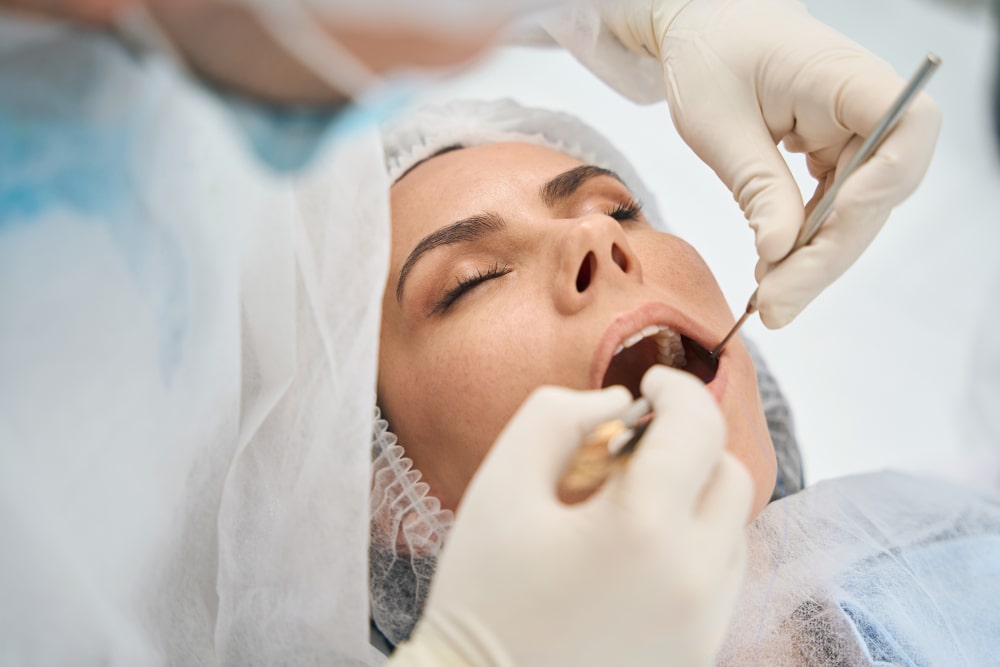When It Hurts So Much, You Just Want It Gone
When your face is swollen, your gums are throbbing, and the pain is shooting up your jaw like a live wire — it’s natural to want the fastest possible solution. For a lot of people, that means one thing: just pull it. Get the tooth out, stop the pain, and move on.
But with abscessed teeth, it’s not that simple. In fact, pulling an abscessed tooth without first treating the infection can lead to bigger problems. Much bigger. We’ve seen cases at Dawson Dental where patients waited too long or tried to fix it themselves — and what started as a toothache turned into a serious, sometimes dangerous, medical issue.
If you’re in pain, you deserve relief. But you also deserve a treatment that won’t make things worse. Let’s walk through what’s actually happening when a tooth is abscessed, and how to handle it safely.
What’s Really Going On With an Abscessed Tooth
An abscess isn’t just a sore tooth. It’s a sign that infection has gone deeper — beyond the surface of your gums or enamel, into the bone or tissue around the tooth.
There are two main types of dental abscess:
- Periapical abscess – the infection starts inside the tooth, usually from untreated decay or trauma. It spreads down to the tip of the root.
- Periodontal abscess – the infection comes from the surrounding gum or bone, often due to advanced gum disease.
Both involve pus, inflammation, and pressure. That pressure causes the throbbing pain — especially when you bite or chew. Other symptoms might include:
- Swelling in your gums or face
- A foul taste in your mouth (from leaking pus)
- Fever or feeling “off”
- Tender or swollen lymph nodes in your neck
- A pimple or blister on the gum that may drain occasionally
The key thing to know? An abscess means your body is trying — and struggling — to contain an infection. And pulling the tooth without managing that infection doesn’t always help.
Why People Want to Pull an Abscessed Tooth (And Why It’s Not Always Right)
People don’t usually take tooth extraction lightly. But when you’re in pain, the idea of pulling the tooth can feel like the most direct path to relief.
Here’s what often drives that thinking:
- It hurts, and they want it over with
- They’re scared of root canals — either from bad past experiences or horror stories
- They worry about cost — assuming an extraction will be cheaper than other treatments
- They don’t have a regular dentist and are looking for a quick fix
- They’ve been told “just get it pulled” by someone who meant well but wasn’t qualified
The issue isn’t that extraction is always wrong. It’s that doing it while the infection is still active — especially without diagnosis or prep — can cause more damage than the original problem.
The Risks of Pulling an Abscessed Tooth Too Soon
Pulling an abscessed tooth may seem like a shortcut. But if the infection isn’t managed first, or if it’s done in the wrong setting, it opens the door to a range of complications — some of which can escalate quickly.
Here’s what can go wrong:
| Risk | What It Can Lead To |
| Spread of infection | Bacteria can enter the bloodstream, leading to sepsis — a life-threatening reaction |
| Jawbone infection (osteomyelitis) | Infection spreads to the bone, causing pain, swelling, and long-term damage |
| Sinus complications | Upper molars are close to sinus cavities; pulling them without care can cause sinus tract infections |
| Delayed healing or dry socket | Especially likely if pus was present and blood clotting is poor |
| Retained infection | If the abscess is not fully drained or cleaned, infection remains in the tissue even after the tooth is gone |
Dentists treat infections before pulling teeth for a reason. In many cases, treating the infection means the tooth can actually be saved — but even if extraction is necessary, doing it the right way protects the rest of your body.

When a Dental Abscess Is an Emergency
Some abscesses stay local. Others don’t. And unfortunately, you can’t always tell the difference just by looking in the mirror.
Here are warning signs that the infection is spreading or becoming dangerous:
- Swelling in your face, jaw, or neck
- Fever over 38°C (100.4°F)
- Difficulty swallowing or breathing
- Pus draining into the mouth or throat
- Severe pain that doesn’t improve with over-the-counter meds
If any of these show up, don’t wait. This isn’t just a dental issue anymore — it’s a medical one. Contact Dawson Dental immediately, or head to urgent care. These are signs that the infection could move into deeper tissues or even your bloodstream.
What Happens If You Don’t Treat It At All?
Sometimes people wait out the pain. Or hope antibiotics alone will make it go away. Or the gum drains a bit and they think, well, it must be healing.
The truth is: untreated dental abscesses don’t just go away. They may settle down temporarily, but the infection remains — and often resurfaces worse than before.
What ignoring an abscess can lead to:
- Tooth loss — the infection destroys the bone and root structure
- Chronic pain and reinfection
- Bone deterioration around the jaw
- Systemic illness — from sepsis to heart issues in vulnerable people
- Emergency hospital visits — sometimes requiring surgery or IV antibiotics
We’re not saying this to scare you. We’re saying it because we’ve seen it. The good news? Almost all of this is preventable with early dental care.
Better Paths: Safe Alternatives to Pulling an Abscessed Tooth
The goal isn’t to delay relief. It’s to get you lasting, safe relief — not a temporary break followed by bigger problems.
Depending on what’s causing the abscess, here are some of the options your dentist may recommend:
Root Canal Therapy
If the infection is inside the tooth, a root canal removes the infected tissue, disinfects the root canal system, and seals the tooth. It relieves pain and saves the tooth — no extraction needed.
Drainage + Antibiotics
In some cases, the dentist will create a small opening to allow pus to drain and prescribe antibiotics to reduce inflammation and stop the spread of bacteria. This stabilizes the area so other treatments can proceed safely.
Apicoectomy
If a root canal doesn’t fully resolve the infection, a minor surgical procedure removes the tip of the root and seals it. Often used when previous dental work has failed.
Delayed Extraction (with infection control)
If a tooth truly can’t be saved, extraction may still be the best option — but only after the infection is under control. You’ll often be prescribed antibiotics first and monitored for readiness.
At Dawson Dental, no treatment is one-size-fits-all. We assess the infection, the tooth, and your health as a whole before moving forward. And we’ll always talk you through the pros and cons of each option — clearly.
When Extraction Is Necessary — Here’s How We Do It Safely
There are times when pulling the tooth is the right move. But it’s never a snap decision.
When we do need to extract an abscessed tooth, here’s how we keep it safe:
- Start with infection control – through antibiotics, drainage, or both
- Monitor swelling and systemic signs – if fever or spread is present, hospital care may be needed first
- Plan the extraction after stabilization – we don’t rush it
- Post-op care – including antibacterial rinses, soft diet guidance, and follow-up checks to prevent dry socket or complications
What we never do is pull a tooth just because it’s easier. We’re here to preserve health — and if we can, preserve your tooth.
There’s a Safer Way Forward
A dental abscess can feel overwhelming. It hurts. It’s scary. And in the middle of it, it’s tempting to take the fastest route — even if it’s not the best one.
But relief doesn’t have to come with risk. Modern dentistry has safe, proven ways to treat infections, save teeth, and restore comfort — without jumping to extraction.
If you’re in pain or suspect an abscess, don’t wait. Book a consultation with Dawson Dental today. We’ll listen, explain your options, and treat the problem with the care it deserves.

